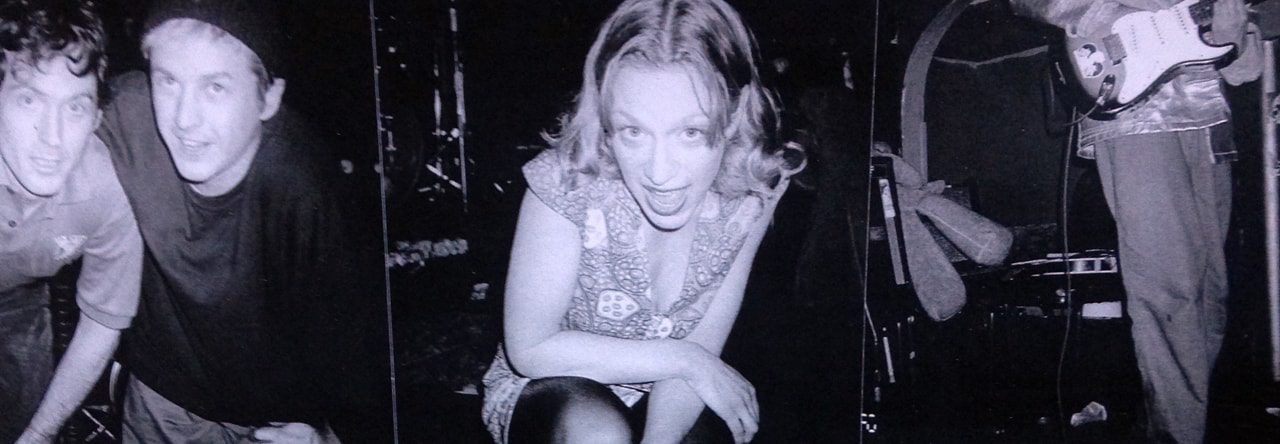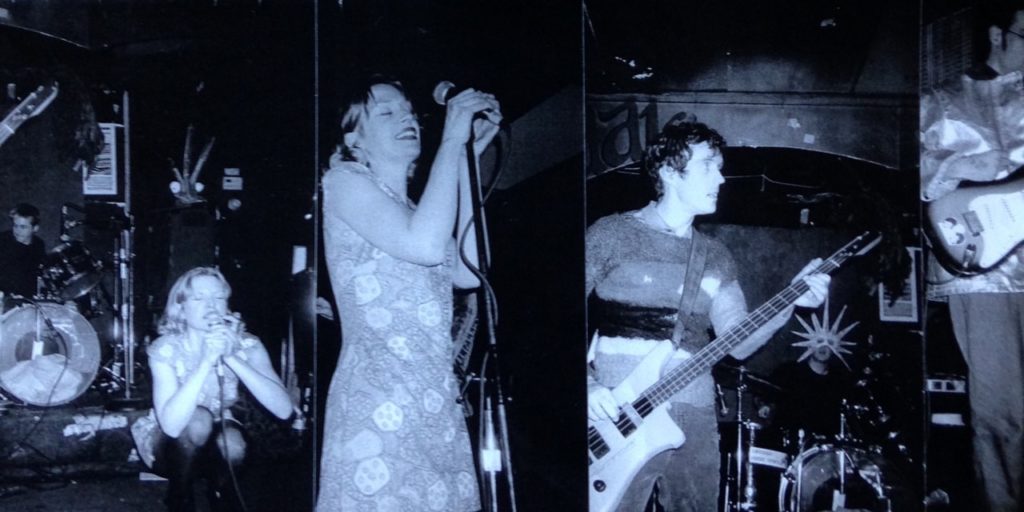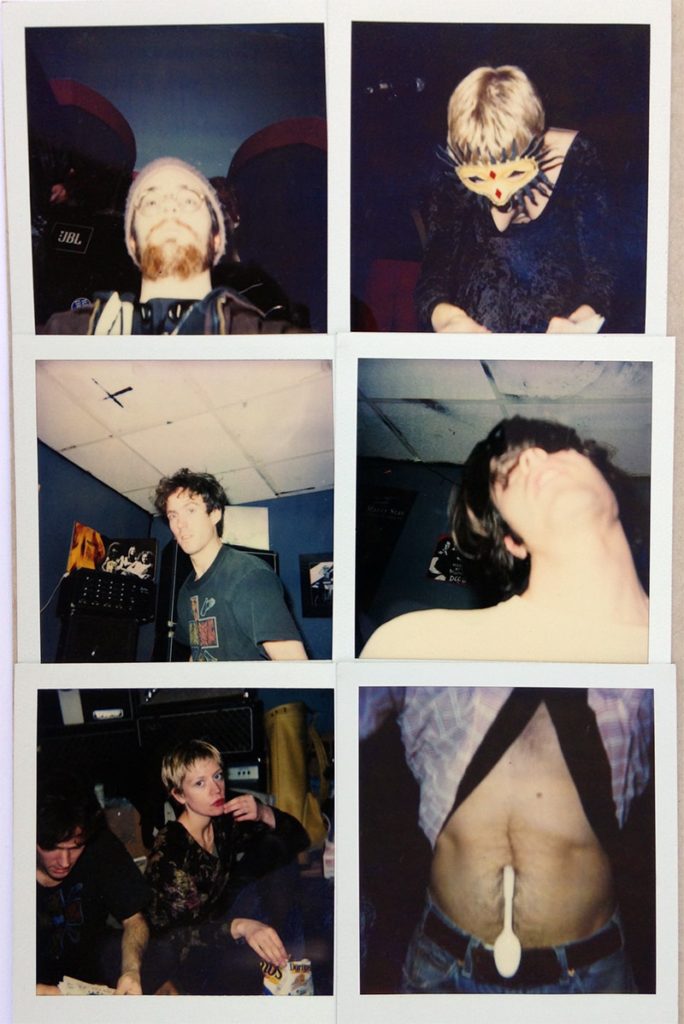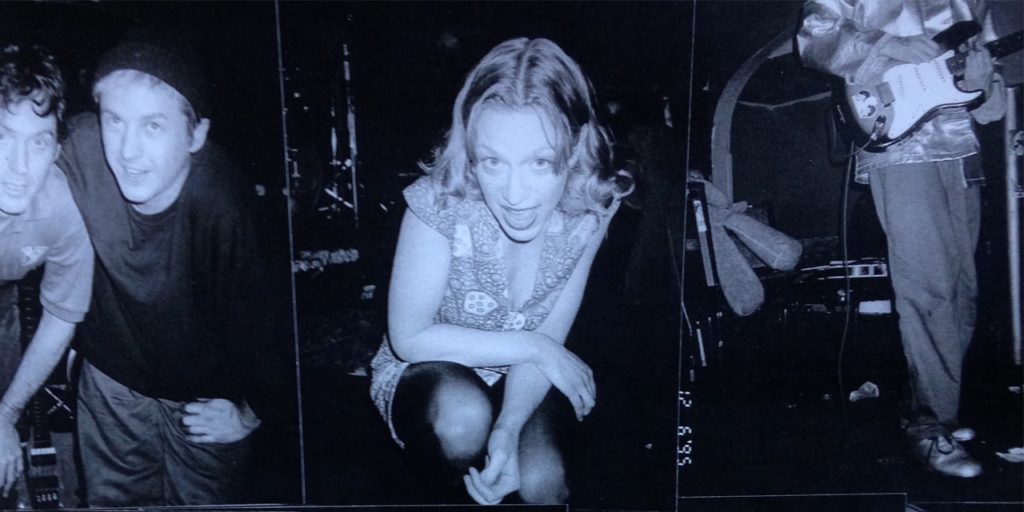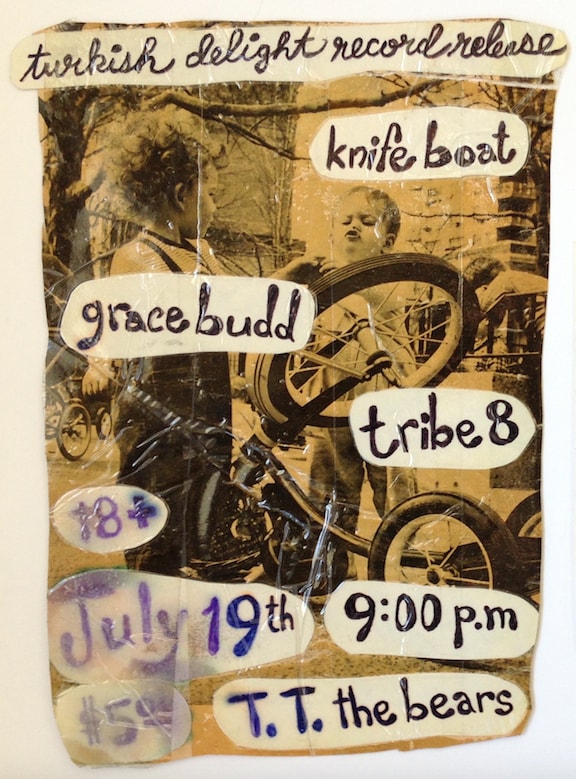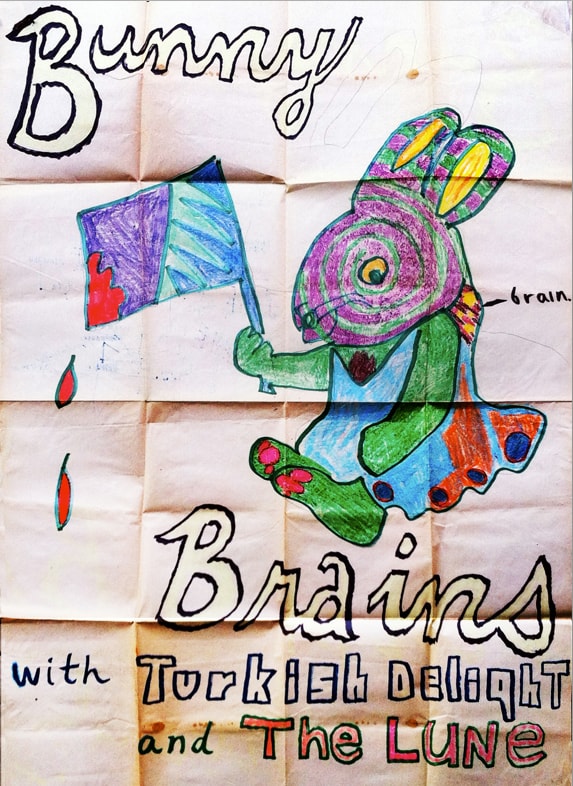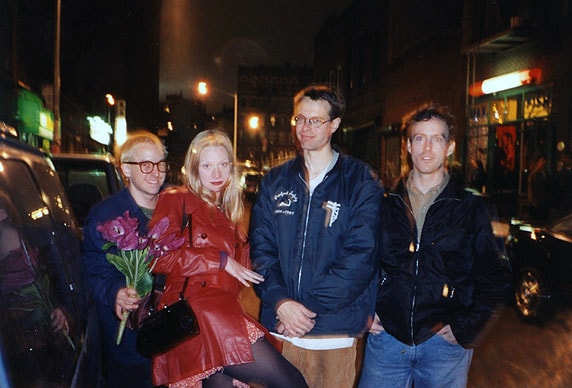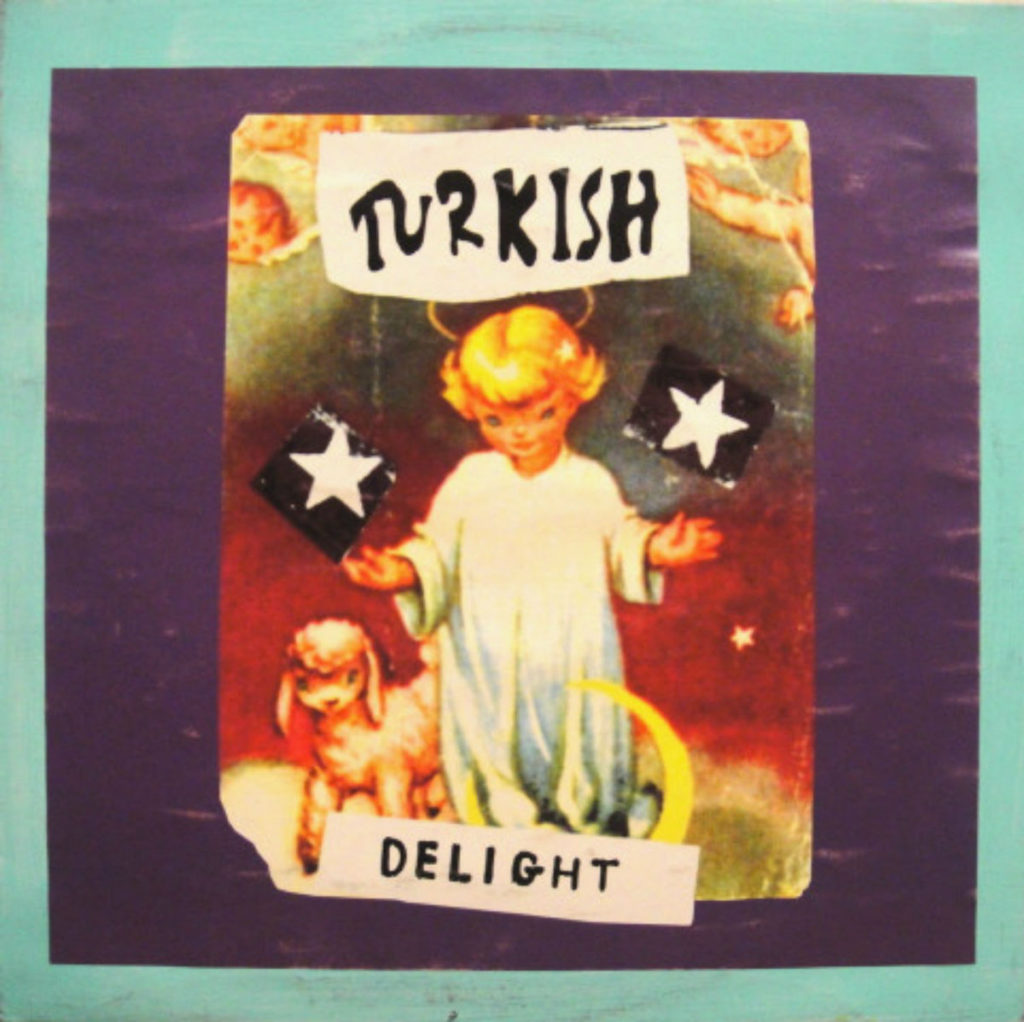2017 has been a great year for reissues — from Kicking Giant to Ut — but I truly couldn’t contain my excitement when Boston label IHeartNoise decided to reissue Turkish Delight’s 1996 debut, “Tommy Bell,” on cassette.
When I lived in Boston, the Turks were an absolutely un-missable live band. Sometimes bands that are stellar live don’t quite translate on record (and vice versa), but TD captured their particular lightning-in-a-bottle with surprising regularity.
Any band that cites influences as sonically diverse as Brian Eno, the Residents, Fred Frith, the Ex, Cecil Taylor, Contortions, Polvo, Dog Faced Hermans, Pharaoh Saunders, Eno, Sonic Youth, Zeena Parkins, and Peter Brötzmann (for starters) is bound to be difficult to pin down, but what’s so surprising — and refreshing — about TD is how adeptly they spun those influences into something uniquely their own.
Although listening to their debut can, at times, be disorienting — so much happening at once — their controlled chaos is tempered by an uncanny pop sensibility, anchored by the arresting vocals of Leah Callahan. (Exhibit A: The shoulda-been-a-hit-in-an-alternative-universe “Spin,” with the wonderfully sing-song chorus, “I’d rather spin/I’d rather spin/I’d rather be a spin-ster,” which encapsulates Callahan’s wry sense of humor.)
Although ostensibly a guitar-bass-drums-vocals setup, TD also incorporated clarinet, keyboards, bells, and, yes, an electric can, homemade by drummer Dave Nelson. Rarely has everything-but-the-kitchen-sink been this fun, or this danceable.
I asked the Turks to tell me their origin story, and look back on what they accomplished in their brief but memorable run. Here’s what they had to say:
- Leah Callahan: vocals, keys, drums, bells
- Dave Nelson: drums, bass clarinet, percussion, electric can
- Carl Thien: bass, vocals
- Darryl Blood: guitar, drums, vocals
How did the band coalesce? Where did the name come from?
Darryl: Dave and I met back in high school, although we went to different schools, we had mutual friends and would meet up. We kept in touch as we transitioned into college. Dave went to UMass Amherst, where he met Leah, and I went to Salem State. They dated for a while, but had broken up by the time Dave and I relocated to Boston in the early 90s, post-college. We were roommates in Allston, in a place we dubbed the “Ugly House.”
That’s where Dave and I started playing music together. We had collaborated before in different ways, but this was the first time we were seriously considering what we did as a “band.” Dave was just starting to play drums. I had some material and was trying out the idea of being the lead singer, but we thought it might be more interesting if we looked for a new singer. We had a couple of demos worked out on the 4-track, one called “If I Die” and another called “Vegetable King.”
This is something at the time which very much inspired me, namely: Live in the moment and do irrational stuff for your art. -LEAH
Dave: An early performance was as the SK-5s, where Darryl, his cousin Mike and I would accost weary afternoon red line commuters in Braintree, blasting a megaphone and two Casio keyboards, feeding back into a harmony amp with tremolo. Very Throbbing Gristle. We would get chased out by the T cops and run over to IHOP to discuss our next move.
Later, seeking to duplicate the rush of accosting a hostile crowd, we entered a Salem State College battle of the bands. We lost power to our SK-5 memory banks 5 minutes into the set and quickly broke into an improvised beatboxing and breakdancing routine, to astonishingly hearty applause. Out of the 6 bands that night we placed 3rd. That experience taught us early on that no matter how good your chops are, in the end it was all about the show.
Darryl: Around this time, Leah came back into Boston. I’m fuzzy on whether she moved into the Ugly House, or was just visiting, but she managed to cut vocals to both of these songs. Dave and I both agreed that there was something there, and the nucleus of the band was born with those two songs. We met Carl through my girlfriend at the time who was in a band called Cheesecake, and he fit the last piece of the puzzle. The timing was perfect. The first time we all got together we knew this was going to be the band, it just locked in.
The band name itself was inspired from CS Lewis’ “The Lion, the Witch and the Wardrobe” — in it, the White Witch tempts Edmund with some Turkish Delight candy. Not sure who came up with the suggestion, but it seemed pretty unanimous when we arrived at the name.
If anything, we wanted to be the ‘anti-band,’ where there was no real focal point, and tried to shy away from any conventional wisdoms of what a rock band should be. -DARRYL
How quickly did your sound come together? You definitely had one of the most distinctive sounds on the Boston scene at the time — part No Wave, part Dada happening but with a definite pop sensibility.
Darryl: I was never really sure how to summarize our sound. I always thought our music sounded like 4 people shouting in a room to be heard. It could get really intense. We were all very dedicated to the democratic process, but we were all pretty strong-willed about our opinions. It was a bit of a pressure cooker, but we got interesting and unpredictable results.
If anything, we wanted to be the “anti-band,” where there was no real focal point, and tried to shy away from any conventional wisdoms of what a rock band should be.
We all had different musical backgrounds that came together in a symbiotic way. I feel like Dave brought the avant garde/jazz element, Leah brought the Dada/minimalist edge, I brought the experimental rock side, and Carl brought the power pop.
This may be too narrow, because we all brought our own unique influences and experiences. Since Dave and Carl were both DJs, I felt that they had a huge range of eclectic tastes, well beyond my own. Leah had a background in opera, plus had a deep passion for literature and feminism. But it all seemed to feed into itself, the way we created music was very democratic, and spontaneous.
We naturally gravitated into this multi-instrumental band. Holding onto to those DIY ethics, I remember thinking, we have all these instruments, why not switch off? There was no competition, it was more like (to Dave), “Hey, if I played drums, that would free you up to play the clarinet or the electric can.” Leah started incorporating keyboards too, Carl added trumpet. It certainly made the stage show more interesting.
Shortly after Turkish Delight formed, I also moonlighted as a full-time drummer in another Boston band, Neptune, so I learned to play drums through all that. I recall one night I actually played a show with Turkish Delight and then had to run across the street and play with Neptune on their set. I was also playing in lots of different side projects with friends too, so there was never a dull moment. A very inspiring and productive period for me.
The sound was the sum of all the parts, we were all crazy in love with all sorts of types of music. Nothing really forced us to decide on one type of genre at any given time. -LEAH
The Turkish Delight “sound” was pretty un-categorizable. How would you describe it?
Leah: The sound was the sum of all the parts, we were all crazy in love with all sorts of types of music. Nothing really forced us to decide on one type of genre at any given time. I do think we wanted the audiences to like us. Which may seem a bit contradictory to the fact that some of our music – and certainly many of my own personal musical influences — could clear a room.
My piano teacher gave me a piece to play by Béla Bartók when I was around 8 or 9 years old, once I heard that something woke up in my brain, a curiosity, an a-ha moment. Suddenly music wasn’t just about pretty songs anymore – it could be about something else. This “something else” kind of sat dormant for several years while I listened to lots and lots of music and went to lots and lots of live shows. I saw some of the greats: Cecil Taylor, Peter Brötzmann, Pharaoh Saunders, Fred Frith, Zeena Parkins and this really obscure pianist named Rebecca La Brecque, to name a few.
Turkish Delight gave me absolute freedom: No one told me what to do and there was no fear of failure. I think this allowed the band to discard preconceptions about what music was supposed to be. I remember one guy came up to me after a Turkish Delight show — he had a very distinguished yet slightly mad professor look going on — and said we had invented a new key signature (I can’t remember exactly what he said but it was something like that); that was the kind of feedback that made me really happy.
Once I had heard Roger Miller had asked who wrote the keyboard parts for our songs. If you’re going to have someone notice your keyboard arrangements, it really can’t get much better than Roger Miller.
I had read that choreographer and dancer Martha Graham once spent the last $200 to her name on flowers for one of her shows. I can’t find this story on Google now. This is something at the time which very much inspired me, namely: Live in the moment and do irrational stuff for your art. And in fact, at the time I was very much influenced by the ideas of the Surrealists, who were very interested in the “irrational,” so you picked up on that with the “Dada happening” reference.
The Turks quickly became part of the Boston/Cambridge scene. I definitely considered TD shows un-missable, but you also played really interesting bills…
Darryl: An aspect to the Turks I think should be noted is Carl’s knack for booking and billing shows. He was a true ambassador for putting together great bands whenever we played — sometimes we joked around + called him “Reuben Kincaid.”
We shared the stage with some amazing acts, and I know many times Carl was the one behind the scenes making it happen. Dave and Leah also had strong promotional skills of their own, so the three of them were definitely a force to be reckoned with. Our first gig was with Kudgel, and it was totally sold out! Talk about a built-in audience.
As a result, I was exposed to tons of great eclectic bands I may have never sought out on my own. In fact, I’m pretty lazy when it comes to discovering music. Serendipity has usually been the divining hand.
Carl: We were fortunate to start at the top and maintain that throughout — VERY lucky!
Leah: I worked at this little retail store in Cambridge, my boss was this sweet quiet woman in her 40s-ish. The one show she came to see me queercore Tribe 8 came out on stage after us and pretended to chop off d*icks. I was worried I had offended her sensibilities, but instead her boyfriend at the time was like, “This is interesting — let’s stay.”
Carl: We were nearly banned from TT the Bears after that show.
Tribe 8 said I was “alright for a guy” — they let me play the guy who got castrated (during the song “Frat Pig”). They had a rubber phallus that they indeed cut off (they gave me the stub to keep).
During that same show Lynn Breedlove (vocalist) had a nipple pierced on stage by Boston’s premier dominatrix (can’t remember her name). THAT was the stunt that freaked TTs…!
Darryl: The Bunny Brains bill was pretty crazy too. I remember some guy (maybe the lead singer?) whacking off on a huge fake dildo coming out of his pants, while dozens of stuffed animals were being decapitated and thrown out to the audience.
TD shows were insanely fun, and definitely broke with the fairly common indie‐rock school of zero motion onstage. Much of this was down to Leah’s love of costumes, glitter and flinging candy projectiles into the audience. Leah, how important was it for you to break that fourth wall and make the shows more communal/theatrical?
Leah: I think everyone in the band was in their own right a “showman.” Dave Nelson’s grandfather was in a post-vaudeville era band called the Harmonicats; Dave and Darryl are both visual artists and they brought those ideas to our live shows. Dave and Darryl also both created their own instruments, Carl played a “rubber band” bass which was intended to be used as a practice bass. Although not an artist myself per se, I was very much influenced by art, film and books at the time.
Together the 4 of us had a youthful exuberance and imagination which we channeled on stage. Even now, with the rerelease of our first album by IHeartNoise, someone on Twitter who’d heard us for the first time called us “Sonic Youth from the Berenstein Bears’ universe.” It’s fascinating to me that in these 20-plus-year-old recordings this sincere, unaffected quality comes across somehow.
Another interesting example: We have a song called “Li Colt Vas” which uses lyrics that Carl had written as a small child; he had invented a nonsense language. Carl brought the idea to the table and we were all like, “Good idea.”
In hindsight I think every idea anyone had was a “good idea.” We never placed limits on what was acceptable or not acceptable when it came to creativity.
As far as the costumes, and the stuff we threw out into the audience, they were often a happy accident as opposed to something we strategically planned.
There was a spot called “The Free Store” at the food co‐op in Allston. On any given day, I would find: a moth-eaten lace wedding gown (with which I proceeded to channel Miss Havisham), a long white taffeta skirt that I painted inspired by an ancient goddess statue, a silk velvet purple 1920s gown where I imagined I was some unnamed long-dead gangster moll.
For our very first show, Dave had found a couple hundred hand puppets thrown out in some company’s dumpster. We made stickers for them with our band name, and the audience liked them. It made the stage fright I was battling a lot easier to see a hundred people letting loose with these hand puppets — after that we always wanted to have something fun to hand out at shows.
To go back to your point about “indie-rock school of zero motion” — I think we had genuine gratitude for people coming out to our shows, and perhaps we felt like they deserved an interesting experience.
I think our performances also consciously reflected an irreverent attitude towards the whole mainstream performance idea, the plastic phoniness of it where people have huge budgets, background dancers and fancy costumes. We often invited random audience members to be our “background dancers” — sometimes it was chaotic and occasionally they were somehow strangely coordinated.
Also I was a sponge for ideas in my teens and twenties and I sought out bands who would really do something memorable onstage; something I hadn’t seen before, something that challenged my view of the world, made me say “WTF is this?” People probably never had the same experience twice at a Turkish Delight show — I certainly didn’t!
Dave: We always treated the shows like parties, plastering all our favorite hangouts in the city with hand colored flyers and sending out postcard invites with personal messages to everyone on the mailing list.
For our first 7-inch “Try Harder,” we had several record sleeve-making parties and dozens of friends came to make collages from stacks of old magazines and obsolete textbooks. Each copy of those 800 singles is unique.
I think this also speaks to the socialist philosophy of the band. Rather than have one idea win over another, we would just collage all of the ideas together.
You can hear it in the music, and that’s why reviewers had fits trying to categorize us.
TD songs were striking both musically + lyrically — sometimes dark, sometimes silly, but always arresting. What was the process for bringing the elements together?
Darryl: We had sketches of musical ideas that we’d present at rehearsals. We would riff off each other, until something rose to the top. Pretty much all the songs started this way, and when it felt like we had a little bit of a structure, Leah would come in with some vocals.
I liked the way Dave approached his drums, because every section seemed like a puzzle piece, and he fit them together in curious ways. Many times in reaction to what would normally “work,” throwing in off-beats or strange time signatures. We would often dissect transitions and see how far we could push them.
Turkish Delight gave me absolute freedom: No one told me what to do and there was no fear of failure. -LEAH
Carl had a great sense of melody in his basslines, so they added that pop sweetness that cut through the chaos.
Leah would always have notebooks full of ideas, and start from those or sometimes she would sit and write while we worked out parts. I found her lyrics to be very personal, and always had an acrid wit to them — she challenged the listener with wordplay, but kept it short and sweet. She never minced words, and I feel like each sentence served a purpose.
Leah: As a band, we didn’t really have this thing where it was verse chorus verse and the drummer did the drum parts, the bassist did the bass parts, the guitarist did the guitar parts, the singer did the song parts. Although sure sometimes one of us would come up with a verse and a chorus — take for example “In My House,” “Living for Today” or “Don’t Look at Me.”
Any given member of the band might come in with a melody. Carl had melodies, he played trumpet too. Darryl had drum parts, and sometimes played the drums. Dave had melody ideas he played of course, the Can and the clarinet. People probably had ideas for my vocals, and as Darryl said, it was probably combustible sometimes, but I respected everyone equally musically and was of course always interested in learning so I am sure I made changes, alterations at times — as did the others.
To speak for myself, I tried to use my voice less as a melodic standalone and more as an instrument, as if I were a trumpet, a drum or a guitar. I had ideas about percussion, about sound. I remember speaking about “Spin” before we wrote it. I remember asking people if they could play as they sounded like they were spinning — I may have had a poem called “Spin,” I really don’t remember. But whether I thought it or said it out loud, you can hear the influence we all had on each other, Darryl’s handmade guitar sounds like it’s spinning, as does Carl’s rubber band bass, Dave’s drumming.
The CAN! The can could definitely be considered a fully-fledged band member. Tell us the band’s origin story (yes, like a superhero). Where is the CAN today?
Dave: I still have the electric coffee can and my kids have taken over making barnyard sounds with it.
“Tommy Bell” was released by impeccably-curated Boston label Castle von Buhler (CvB), which not only released an incredible string of records in its brief run, but all were designed by Clif Stolze of Stolze Design (and a definite fan of the Vaughan Oliver school of surreal graphics). How did you meet Clif? What ideas did he bring to crystalize the band’s visual appeal?
Leah: I think Clif may have heard about us through the grapevine, I think that’s how we initially met CvB, the label, Cynthia and Adam von Buhler. Cynthia saw us perform at the CvB “Nigh” compilation show — that’s when she popped the question about being on her label. I think she had the idea on the spot. I, of course, was flattered and elated. I continued a relationship with Clif long after Turkish Delight ended, we collaborated on many artistic projects. He loves music and he’s a great guy!
Labels like CvB and Archenemy opened doors for us, and, in some cases having us on their labels helped them get their own personal musical projects heard. I am indebted and extremely grateful to them and now to IHeartNoise —and to anyone who helped us along the way.
Turkish Delight’s rather omnivorous sound drove reviewers to fits to try to find antecedents or analogs. Who would you cite as primary influences on the band’s sound?
Darryl: I remember specifically one night Dave and I had gone out to a show together at the Middle East, this was probably around the time the band was forming in the early 90s, not sure of the time line. There was a band playing called the Ex, and the guitarist was fantastic. The way he was physically attacking his guitar while keeping in a frenzied rhythmic pace was totally inspiring to me. Their whole sound was just bombastic and sounded so freeing.
I really wanted to reach those kinds of heights, and it definitely created a spark for how I wanted approach my guitar playing. I was a bit turned off by the idea of taking solos, so instead, this was a practical application. I had a credo back then: “Solos Kill Rock.” Just attack the guitar with all you’ve got, and let the noise be the solo. This was a carry-over from the experimental sound I had already enjoyed from Sonic Youth, but somehow, seeing it that night just clicked. It was a final solution to the puzzle.
I can’t say I recall any specific reviews that stood out to me, but I do remember Roger Miller (Mission of Burma) was an early champion of our music, and even called it “beautiful noise,” or something to that effect. I was blown away and humbled by that, to say the least. We shared a stage with him one night too, pretty amazing to have his support. The one thing I regret was all the vocal screaming I did in the band. I ruined a couple of songs doing that. It sounds so dated and angsty. I wished I had just stuck to harmonizing or just “singing.”
I had a credo back then: “Solos Kill Rock.” Just attack the guitar with all you’ve got, and let the noise be the solo. –DARRYL
Leah: One of my favorite reviews was someone who said we need to “go back to music school.” To answer to that reviewer now many years later — we had a lot of influences, a lot of education; probably as 4 young people at that time in our lives had listened to more diverse and more interesting music than many of our peers. We simply weren’t interested in playing by the rulebook.
The review is memorable because after reading it we wrote a really cool song called “Metronome.” As a Turkish Delight fan myself, I do have to say it had impressive time changes and went very interesting places sonically and rhythmically. No music school needed there, thank you very much!
Darryl: As far other musical influences of that time, I want to give props to POLVO. “Celebrate the New Dark Age” + “Today’s Active Lifestyles” got frequent spins and constant study. I saw them live a couple of times too, and they had a big effect on me. Songs like “Fractured (Like Chandeliers)” and in particular, the “Solitary Set,” inspired me to pick up slide guitar, a sound I used on “Grammy,” “Blue Wing,” etc.
The slide I thought was a nice alternative to the whammy bar/Jaguar sound most bands were lifting from MY BLOODY VALENTINE. Don’t get my wrong, I loved that sound too, but I wanted to set our sound apart from the shoegazer scene. Another math rock band I liked around that time was the band DON CABALLERO. I was also into the Japanese Noise scene, bands like the Boredoms, the Ruins, etc.
Fred Frith’s film “Step Across the Border” (1990) had a pretty big impact on me too, as far as re-inventing ideas about how you can play instruments, specifically through the guitar. Frith was an artist Dave introduced to me back in his UMass Amherst college days. He did cool things like arranging chop sticks under his guitar strings and running string through frets to make interesting textures and sounds. It was very playful and experimental all at once, and very immediate. I definitely brought those idea to Turkish Delight, reinforced by artists like Sonic Youth, the Ex, Dog Faced Hermans, The Residents, Laurie Anderson, Brian Eno, etc, who challenged the idea of what sound could be.
One of my fondest memories was seeing Sonic Youth play at the Somerville Theater (1988?) in support of “Daydream Nation.” I remember Thurston Moore had this refrigerator box that he dragged across the stage, stuffed full of guitars, and I could see all the tunings he had scribbled in sharpie on the backside of the guitar necks. I just loved the rawness of that moment, and how revealing and humanizing it was.
Open tunings became a fascination for me shortly after that. My cousin Michael Anderson, AKA Drekka, once sent me a list of some open tunings he had read about the Red House Painters using, and I co-opted some of those from that list for most of my Turkish Delight songs. I loved the sense of discovery I’d get when I was in a weird tuning — it reset my creative process and I’d just get lost in it. Many songs emerged that way.
From a very early age, I was interested in how sound worked. I was really into the Beatles since I was about 8 years old, and I had this turntable where you could turn the balance knobs extreme left or right. I would listen for hours to albums like “Revolver” and listen to how they spread out the instruments from speaker to speaker. It’s also how I learned to play guitar, because sometimes I would get all rhythm guitar on one side, or maybe a solo, so I could just sit and listen to that part over and over.
Another influential band of that time (at least to me) was the Dog Faced Hermans (from Scotland). In fact, I think their sound was even more influential. Just listen to the opening track off their 1993 album “Hum of Life.” We are SO BUSTED!
Any reunion shows in the works?
Darryl: I would LOVE to do a reunion show. It’s just a matter of logistics since I’m out here in Los Angeles. If I could find a way to get the funds to afford to fly there for a couple of weeks, I would totally do it, but it would also mean bringing out the whole family, and during a time when school’s out for my boys and off season for my wife. If the stars align, and we’re all in agreement, I’m totally there, in a heartbeat. It would be a blast!
SEE/HEAR TURKISH DELIGHT:
TD on Instagram
“Howcha Magowcha”
Gull Boy (Carl’s current band)
Darryl Blood on Bandcamp
Invisible Soundtracks

